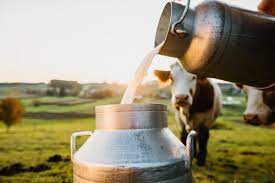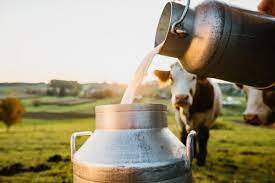
Milk prices are rising, and they are not anticipated to decrease until November in India, the world's dairy superpower.
“In the last 15 months there has been [an] extraordinary increase in milk and dairy products, around 14-to-15%,” said RS Sodhi, former managing director of India’s number one dairy company, Gujarat Cooperative Milk Marketing Foundation.
A contagious bovine disease, rising ice cream demand, and increasing feed prices are a few of the causes contributing to the price hike.
India, the top milk-producing country in the world, produces 22% of the world's milk, with the United States, China, Pakistan, and Brazil following.
Data from the food commodity pricing database Mintec shows that from November 2021 to the beginning of May, milk prices in India increased from 46 to 53 rupees per litre (between $0.55 and $0.64).
For Indians, who consume the most milk in the world, this is a financial hardship.
“In India, every household buys milk everyday. Per capita consumption is around 440 grams per person per day. Every Indian starts [the day] with milk,” said Sodhi.
“In the morning people drink milk, from the bottle, or in tea and coffee … a lot of Indian desserts are mostly made out of milk only,” he added. Other milk-based local favorites include paneer, ghee and yogurt — all of which are staples in Indians’ regular diets.
The surge in milk prices is a result of higher cattle feed costs that coincide with the period of greatest demand.
“An upturn in feed prices has discouraged farmers from providing their cattle with sufficient feed,” said Matthew Biggin, commodities analyst at Fitch Solutions’ research unit BMI.
According to India's National Dairy Development Board, among other grains, corn, wheat, rice, and oats are frequently used as cattle fodder. Many of those elements had significant increases in the middle of last year and are still at elevated levels. Russia's invasion of Ukraine disrupted supply lines and increased prices, which contributed to some of the price increases.
Cattle ranchers have to contend with increasing transport, storage, and energy charges in addition to rising feed costs, according to Biggin.
The dairy industry was already suffering from the pandemic's effects before the rise in input costs.
“The sector was already under pressure, still feeling the effects of the pandemic where demand was hit, putting smallholder farms, which make up a significant part of the Indian dairy sector, under financial strain and driving a reduction in the pace of breeding,” he said.
Prices will continue to be supported until 2023 by an increase in demand for goods like ice cream as the nation moves into the summer season and the ensuing religious holidays, when milk-based sweets are a mainstay.
Additionally, lumpy skin disease, which caused blisters and decreased milk production in cattle stock, affected millions of the nation's dairy herd population.
“Lumpy skin disease is estimated to have killed or emaciated over 300,000 cattle last year, negatively impacting milk production,” Mintec’s Dairy and Pork Analyst Sandro Schulz said.
According to BMI's Biggin, India's milk production will "likely remain pressured" and increase the nation's reliance on imports, particularly as the industry enters the period of peak demand.
“An uptick in demand for products such as ice cream as the country enters the summer months, and then the following religious holidays where milk-based sweets are a staple, [alongside] limited domestic supply will continue to support prices throughout 2023,” he predicted.
In November, Hindus, Jains, and Sikhs around the world will celebrate Diwali, also known as the Festival of Lights, one of the biggest religious festivals in India. The Indian sweet Mithai, which is largely made of milk, wheat, ghee, and sugar, is the centrepiece of the celebrations.
“That said, as prices remain elevated, consumers will be incentivized to substitute for alternative products and limit their consumption, helping to keep a lid on more substantial increases,” Biggin said.
Similarly, Sodhi anticipates a decline in pricing following Diwali, which occurs in November this year. According to him, milk prices could decrease by 2 to 3 rupees per litre to about 50 rupees.
“After Diwali, prices will be stabilized — may go down, but I don’t foresee a major decline.”
(Source:www.cnbc.com)
“In the last 15 months there has been [an] extraordinary increase in milk and dairy products, around 14-to-15%,” said RS Sodhi, former managing director of India’s number one dairy company, Gujarat Cooperative Milk Marketing Foundation.
A contagious bovine disease, rising ice cream demand, and increasing feed prices are a few of the causes contributing to the price hike.
India, the top milk-producing country in the world, produces 22% of the world's milk, with the United States, China, Pakistan, and Brazil following.
Data from the food commodity pricing database Mintec shows that from November 2021 to the beginning of May, milk prices in India increased from 46 to 53 rupees per litre (between $0.55 and $0.64).
For Indians, who consume the most milk in the world, this is a financial hardship.
“In India, every household buys milk everyday. Per capita consumption is around 440 grams per person per day. Every Indian starts [the day] with milk,” said Sodhi.
“In the morning people drink milk, from the bottle, or in tea and coffee … a lot of Indian desserts are mostly made out of milk only,” he added. Other milk-based local favorites include paneer, ghee and yogurt — all of which are staples in Indians’ regular diets.
The surge in milk prices is a result of higher cattle feed costs that coincide with the period of greatest demand.
“An upturn in feed prices has discouraged farmers from providing their cattle with sufficient feed,” said Matthew Biggin, commodities analyst at Fitch Solutions’ research unit BMI.
According to India's National Dairy Development Board, among other grains, corn, wheat, rice, and oats are frequently used as cattle fodder. Many of those elements had significant increases in the middle of last year and are still at elevated levels. Russia's invasion of Ukraine disrupted supply lines and increased prices, which contributed to some of the price increases.
Cattle ranchers have to contend with increasing transport, storage, and energy charges in addition to rising feed costs, according to Biggin.
The dairy industry was already suffering from the pandemic's effects before the rise in input costs.
“The sector was already under pressure, still feeling the effects of the pandemic where demand was hit, putting smallholder farms, which make up a significant part of the Indian dairy sector, under financial strain and driving a reduction in the pace of breeding,” he said.
Prices will continue to be supported until 2023 by an increase in demand for goods like ice cream as the nation moves into the summer season and the ensuing religious holidays, when milk-based sweets are a mainstay.
Additionally, lumpy skin disease, which caused blisters and decreased milk production in cattle stock, affected millions of the nation's dairy herd population.
“Lumpy skin disease is estimated to have killed or emaciated over 300,000 cattle last year, negatively impacting milk production,” Mintec’s Dairy and Pork Analyst Sandro Schulz said.
According to BMI's Biggin, India's milk production will "likely remain pressured" and increase the nation's reliance on imports, particularly as the industry enters the period of peak demand.
“An uptick in demand for products such as ice cream as the country enters the summer months, and then the following religious holidays where milk-based sweets are a staple, [alongside] limited domestic supply will continue to support prices throughout 2023,” he predicted.
In November, Hindus, Jains, and Sikhs around the world will celebrate Diwali, also known as the Festival of Lights, one of the biggest religious festivals in India. The Indian sweet Mithai, which is largely made of milk, wheat, ghee, and sugar, is the centrepiece of the celebrations.
“That said, as prices remain elevated, consumers will be incentivized to substitute for alternative products and limit their consumption, helping to keep a lid on more substantial increases,” Biggin said.
Similarly, Sodhi anticipates a decline in pricing following Diwali, which occurs in November this year. According to him, milk prices could decrease by 2 to 3 rupees per litre to about 50 rupees.
“After Diwali, prices will be stabilized — may go down, but I don’t foresee a major decline.”
(Source:www.cnbc.com)





